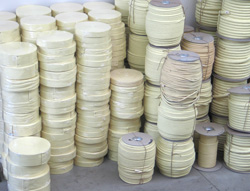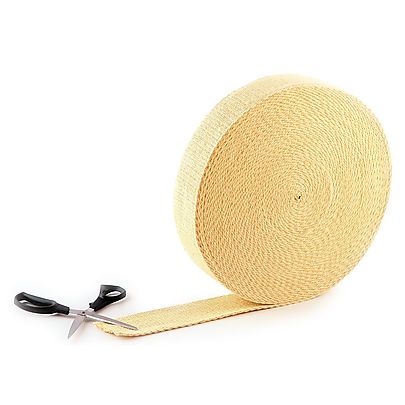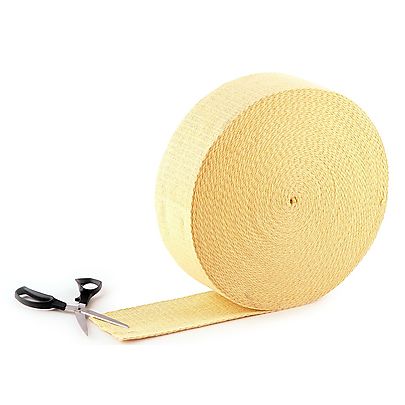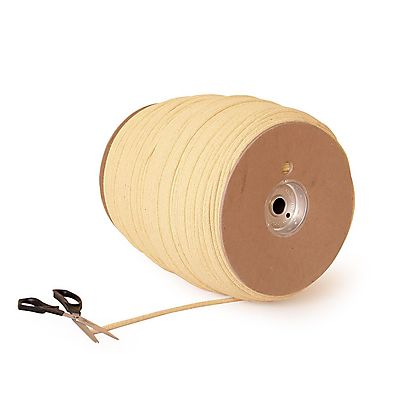
I have written this article to explain all the pros and cons for each material that you can use as a wick on your fire equipment.
Warning: Be very careful how others describe their Wicks. Using words like "Professional" grade is just a marketing ploy. And saying "does not contain Fiberglass" as an advantage is very misleading. Saying that aramids or Kevlar do not burn or degrade is far from the truth. Read on and make your own conclusions.
Table of contents
- Towel
- Denim
- KEVLAR ®/Aramid woven with Cotton
- Glass Fibre/ Glass Fiber / Fiberglass
- KEVLAR ® or Aramids woven with glass fibre (as sold by us)
- KEVLAR ® or Aramids woven with metal wire
- 100% KEVLAR ® or 100% Aramid
- Tips and Notes
- References
Towel
Towels made from 100% cotton generally have a loose weave in order to soak up lots of moisture. So yes they will soak up more fuel and provide you with a much longer burn.FOR
- Best fuel soakage.
- Very cheap to set up.
- Has a consistent burning time.
- Will not last as long as the wick options below.
- May end up costing you more in the long run because of the life of the product. Unless you have a super cheap supplier and don't mind remaking the wicks each time.
- Possible added danger. Towel wicks disintegrate after a few burns which will mean lots of burning pieces flying through the air even when wicks knock together.
- Cotton destroyed at about 600°F (315°C).
Denim
Denim is made from Cotton in a twill weave. Great if you have an old pair of Jeans you do not want to wear.FOR
- Reasonable fuel soakage but will be less than towel.
- Weave is dense and will not burn up as easily. Should last quite a bit longer than towel.
- Has a consistent burning time.
- Much cheaper than KEVLAR ® blends
- Will not last as long as the wick options below.
- Will end up costing you more in the long run because of the life of the product. Unless you have a super cheap supplier and don't mind remaking the wicks each time.
- Cotton destroyed at about 600°F (315°C).
KEVLAR ®/Cotton
KEVLAR ®/Cotton is a mixture of KEVLAR ® which provides absorption, weave stability, strength and is interwoven with cotton which provides the more absorption of fuel. Normally this weave is quite thick and when new is a pale white/yellow. As a general rule the more Yellow it is the more KEVLAR ® there is in the mixture. This mixture is good and will last many burns. Thread count will vary the amount of fuel soaked and burning time. The more dense it is the less fuel it will soak but the longer it will last.FOR
- Excellent fuel soakage.
- No worries of burning pieces breaking away until the KEVLAR ® itself starts to fall apart.
- Has a consistent burning time.
- Much cheaper than other blends
- Cotton will quickly burn away leaving a loose Kevlar weave behind which will in turn burn away itself.
- Cotton destroyed at about 600°F (315°C).
- Kevlar degenerates at 650°F (343°C) .
Glass fibre
Glassfibre wicks are made from very small glass fibre yarn (less than 9 microns thick) that are then woven to produce a white, soft and flexible fabric.FOR
- Fibreglass melts at 3000°F (1650°C).
- Fiberglass (yarn grade) degenerates at 1000°F (537°C).
- In the correct weave they are very absorbent.
- Soaks in fuel well.
- Excellent capillary flow of fuel to the flame.
- Excellent abrasion resistance, more so than Aramids or KEVLAR ®.
- Excellent heat insulator (which is why it is preferred for use in a Safety Fire blanket)
- Market perception that this glass fibre yarn is a major irritant to the skin and danger to the body which is untrue. It is however true that many other Fiberglass products have had this problem.
- The pulling strength of Fiberglass is much lower than aramids or KEVLAR ®, but we are not exactly towing cars with the stuff.
KEVLAR ® or Aramids woven with glass fibre
As sold by Home of Poi, KEVLAR ® woven with glass fibre uses KEVLAR ® which provides absorption, and includes fiberglass for abrasive protection and like the cotton provides good absorption properties. Should last a long time with good handling. Has a consistent burning time.FOR
- Fibreglass will not melt.
- Fiberglass (yarn grade) degenerates at 1000°F (537°C).
- In the correct weave they are very absorbent.
- Soaks in fuel well.
- Excellent capillary flow of fuel to the flame.
- Excellent abrasion resistance, more so than Aramids or KEVLAR ®.
- Excellent heat insulator
- Kevlar degenerates at 650°F (343°C).
- Market perception that glass fibre yarn is a major irritant to the skin and danger to the body which is untrue. It is however true that many other Fiberglass products have had this problem.
- Market perception that inclusion of Glass fiber means the product is an inferior wick. When in fact it can handle much higher temperatures, is non-smoldering and has better abrasion protection than Aramids or KEVLAR ®.
After our wicks have smoldered (after fuel is all gone) people notice the wicks fabric turning white in colour, this is because the KEVLAR ® and Aramids have broken down leaving the fiberglass to maintain the structural integrity of the rest of the wicks. - KEVLAR ® and Aramids degrade slowly when under daylight (UV).
KEVLAR ® or Aramids woven with metal wire
The KEVLAR ® and/or Aramids provide the absorption, and includes metal wire for abrasive protection and to prevent the weave falling apart prematurely. Should last a long time with good handling. Has a consistent burning time.FOR
- Copper Wire is quite happy up to 1083°C (1981°F) - 1650°C (3002°F). Much higher than KEVLAR ®!
- In the correct weave they are very absorbent.
- Soaks in fuel well.
- Excellent capillary flow of fuel to the flame.
- Wire provides excellent abrasion resistance, more so than Aramids or KEVLAR ®.
- Copper wire can not handle temperatures as fiberglass can. Fiberglass handles up to 1650°C (3002°F)
- Copper wire is a very good conductor of Heat and can burn you more easily. Should never be used in the mouth (Fire eating). Fiberglass is a far superior heat insulator.
- Very thin copper wire often breaks and become a sharps hazard. But no more harm than an ouch! if it comes out again
100% KEVLAR ® or 100% Aramid
100% KEVLAR ® or 100% Aramid would definitely be the most expensive form to make a wick out of. Most shops put "KEVLAR Wick" and omit everything else in the weave.FOR
- Sounds good ie "I am using professional 100% KEVLAR ® wicks"
- In the correct weave they are very absorbent.
- Soaks in fuel well.
- Excellent capillary flow of fuel to the flame.
- Reasonable abrasion resistance, although much less than wire inserted or fiberglass.
- Excellent heat insulator
- Great for towing cars???
- Looks like really good superior and solid wick at the start
- Kevlar degenerates at 650°F (343°C).
- Weave will fall apart and wear quicker than Wicks woven with metal strands or fiberglass.
- KEVLAR ® begins to disappear at 427°C (800°F). turns into a gas.
- KEVLAR ® and Aramids degrade slowly when under daylight (UV).
Tips and notes
- Nomex degenerates at 450°F (232°C)
- Fire may get to about 800°F (426°C) however under the flame it will be much cooler.
- Some weaves have metal thread in it to provide rigidity to the weave. Not recommended for eating with because of the very hot metal fibres.
- PVA, Elmers or white school glue can be used on the edges of all these wicks to provide enhanced abrasive resistance. The heat will harden and cure the glue.
- Wrap KEVLAR ® blend wicking over cotton wick. Fuel from Cotton will feed into the Kevlar ® blend where it will be burnt.
- There are many manufacturers of these products around the world. Differing weaves and mixtures of the materials making up the weave can affect soak-ability, wear and tear, abrasive and burning characteristics. So these factors should also be considered. Just because one is cheaper does not mean it will be cheaper in the long term. Also one blend may be weaved to produce different characteristics of another wick of the same blend. What you use will most probably come down to where you are, how long you need it to last, what you want to spend and what is readily available.
References
See also What is KEVLAR ®?, How to make your wick last longer?, Fire head construction, All about metal parts used in fire twirling equipmentReferences KEVLAR® technical guide, KEVLAR® Para-Aramids - NOMEX®
Use of the KEVLAR ® brand in any printed brochures, catalogues, packaging, exhibition mediums, websites, Internet pages, or any other materials is not permitted without a license from DuPont.



